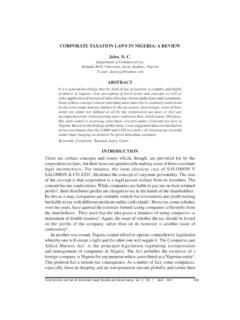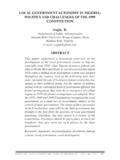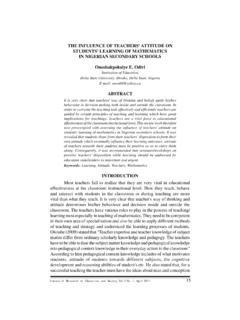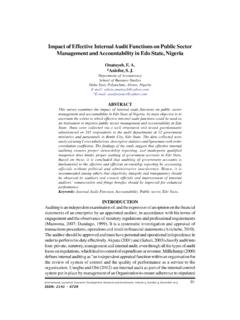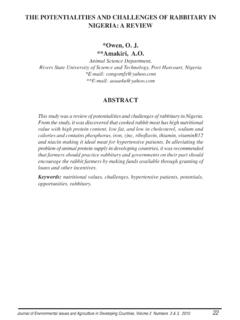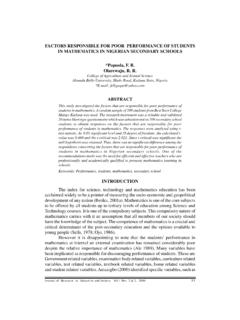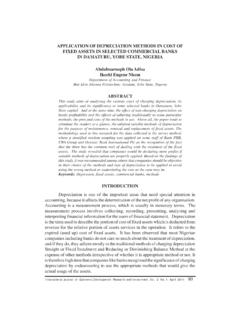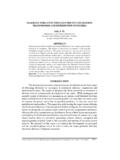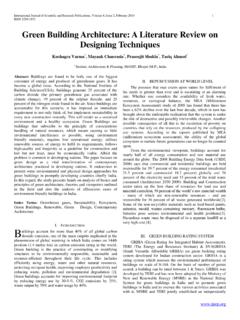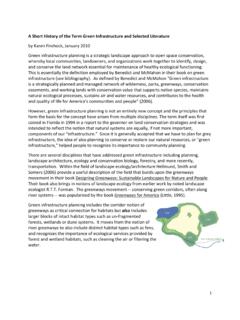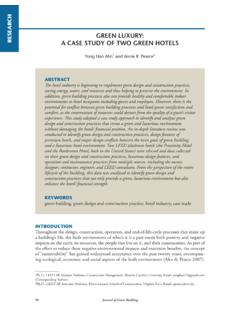Transcription of importance of climate - Welcome to International Centre ...
1 importance OF climate TO ARCHITECTURAL. DESIGNS IN NIGERIA. Agboola O. P. Department of Architecture Osun State College of Technology, Esa - Oke, Osogbo, Osun-State E-mail: ABSTRACT. Among the basic necessities of life is shelter, after food, housing has always been rightly assumed to be the next essential human need. As a result of this, the construction of buildings in which people live and work has been a major concern since the early times when human being first made huts of stick, mud or rock. It later developed into the use of bricks, stones, timber, organic and inorganic wastes.
2 This paper focused on the need to develop and design an appropriate building suited to their purpose, taking into cognizance the various environmental elements acting on the structures. The research method adopted for this paper was based on an in depth literature review. This paperreiterated the need for architects/designers to design in relation to climate , in order to achieve pleasant, comfortable and conducive structures that ensure physiological and psychological comfort of the occupants. As a result of which, there will be a reduction in substantial amount expended by people to achieve thermal comfort within and around the building, through the use of mechanically controlled measures.
3 This study concluded by giving appropriate design guidelines and recommends that designers/architects should be equipped with the climatic data required for appropriate architectural designs which will help in the evolvement of designs that best suite the various climatic zones of the country identified. Keywords: Housing, Environmental elements, Climatic zones, Climatic data, Thermal comfort, Design to climate . INTRODUCTION. Environment according to Hornsby (1990) is defined as surroundings, circumstances or influences. Encarta (2005) also defines environment as the physical and material bases of life, including land, air and water as well as the vital material resource and energy in the surrounding of a society.
4 Fadamiro (1998) described environment as "the aggregate of all external conditions and influences affecting the life and development of organisms. It includes living and non-living which influence the life of a man as an organism. Roaf, Fuentes and Thomas (2002) define Buildings as parts of complex interactions between people, the buildings, the climate and the environments. He stressed further that buildings are only parts of our habitat and are intimately linked to the local, regional and global environments that are all parts of our Ecological Niche. It is the responsibility of our generation to adapt to our buildings to ensure that we can stabilize climate change, that we can live without fossil fuels and that we Journal of Environmental Issues and Agriculture in Developing Countries, Volume 3 Number 1, April 2011 15.
5 Do not unsustainably pollute the environments. The natural environment consists of all living organisms which are deeply interdependent on one another for continued survival of life on earth. It does not however preclude those facilities used by these living organisms to enhance their quality of lives. Also, the natural environment has a deep influence upon the thinking of human beings and the way of life, hence human environment is not independent of each other, but are intimately connected and deeply influenced by each other. The concept of Environmental determinism is expatiated thus the effect that the environment has on the actions and character of people and their societies are determined by environmental factors.
6 However, Aribigbola (2000). succinctly describes shelter as the physical shells or the physical elements of housing that protect people from climatic elements such as rain, sun, wind, lighting, among others. The knowledge of the relationship between these environmental element vis- -vis buildings is a fundamental requirement for architecture in Nigeria. Olotuah (2001) buttresses this by saying that the design of pleasant buildings that ensures physiological comfort of users is only achieved through an understanding of the climate and environment (the adjacent system) and the human responsive systems.
7 However, the environmental element includes the weather and climate . The variations in the state of the atmosphere from time to time and from one place to another are described by the two word but they are both concerned with temperature, rainfall, pressures, winds and so on. Jennings (1980) defines weather as the actual state of the atmosphere at a particular moment or over a short period of time. Thus, a sudden shower, an unexpected snow-storm or a dense fog are all illustrations of weather conditions. He further describes climate as the state of the atmosphere that may reasonably be expected to occur at a particular place over a long period usually a month or a season.
8 Umoh (2000) states that Environmental parameters, which affect houses, are temperature, humidity, sun radiance and wind speed. Succinctly put, climate and weather are the major environmental factors which directly affect building forms and designs. Umoh (2000) stresses this building of houses has long been recognized as a function of climatic regimes. In Nigeria, there are different climatic zones which dictate the different architectural design remedies. Ogunsote (1991) identifies six climatic zones which are: the coastal zone, the forest zone, the transitional zone, the savannah zone, the highland zone and lastly the semi- desert zone.
9 These climatic zones help parade a wealth of traditional house forms in traditional architecture, reflect the lifestyle of people and are symbols of heritage of the people, Olotuah (2001) expatiates. In the process of the efforts of the occupant to achieve and maintain thermal comfort in a faulty/poorly designed buildings; it has been discovered that a lot of resources are continually wasted to acquire mechanically controlled measures (air conditioning, fans, heaters etc.). This leads to increase in domestic energy consumption. This is buttressed by Opoko (2001), thus: in order to satisfy this vital need, modern buildings have had to rely on artificial or mechanical means of indoor cooling, which Journal of Environmental Issues and Agriculture in Developing Countries, Volume 3 Number 1, April 2011 16.
10 Increase the cost-in-use of buildings. She furthermore points out that high proportion of energy used in modern building goes towards the moderation of indoor climate , a function which in many cases could have been satisfied at the planning and design stages. It is in this regard that this paper focuses on the importance of climate to design, at the end, functional and well adapted building forms and designs to various environmental zones of Nigeria will be evolved. Hence, saving a lot of money needed to provide the desired environmental comfort. Passive Solar Housing Lawal and Makinde (2007) described passive solar housing as that built in tune with indigenous resources as symbolized and exemplified by the sun and the climate .
